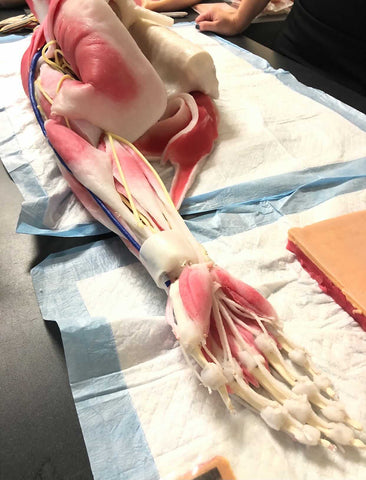There’s been lots of innovation in medical training models for trauma. At some point in everyone’s career, they remember using Rescue Randy, 200 pounds of deadweight with arms and legs. Training evolutions with Randy usually devolve into some level of physical fitness test, which is essentially patient movement training. Important, yes, but has no real value as far as addressing life-threatening wounds. Medics and first responders often “go through the motions” during trauma lanes, “notializing” treatments, and for critical care providers, Randys are practically worthless.

Fast-forward twenty years to the emergence of cadavers in TCCC. This was a great step forward for medical training, but without proper tissue reanimation, field training evolutions would include a lot of “Expectant” casualties on the objective. Most of the models would end up being underutilized, and again, they served the purpose of patient transport models. This isn’t exactly ideal, especially when it’s patient transport using very old, very wrinkly, and very dead grandmother-types that no one wants to touch, weighing all of 70lbs. It would often leave you wondering at the end of a training evolution if Randy was the way to go all along.
Then came the use of synthetic tissue analogs. This is worth mentioning only because of the time, money, and attention that was put into trying to make them work. These are complex mannequins which can be summed up as glorified arts and crafts projects. They have very realistic organ systems compared to a Rescue Randy, but don’t come close to the realism in organ structure, vascular makeup, etc. when compared to cadaver models. What you wind up with is a very expensive and inferior cadaver that smells just as bad. There are probably some applications for partial task trainers, but I think everyone agrees they don’t have a place for TCCC training, especially for $100K each.

The latest innovation for cadaver models is “reanimated” tissue. This is done by gaining vascular access, adding synthetic blood to a reservoir and pumping it through the circulatory system. Cuts to the vasculature “bleed”, which is very realistic, especially if you are into geriatrics – ha! But in all seriousness, at this point in time it’s tough to find a comparison. Some limitations to this approach are the pumps and blood reservoirs, which are large and limit you to tabletop labs where there is access to power. Tabletop is important in a progressive learning approach to reinforce skills, but TCCC training requires “lanes” and typically a MASCAL to teach triage, so not being able to be fully utilized in the field is an issue.
Future training modalities need to address two aspects of trauma training in order to be fully adopted.
The first is the need to maintain competent surgical provider skills in support of Forward Surgical Teams. This means getting more “cuts” and more repetitions in dynamic resuscitative team scenarios. To achieve this, the models need to be hyper-realistic for providers to get training value. The benefit of this for the TCCC approach is pushing the limits of the medics’ scope in regards to Damage Control Resuscitation at the Point of Injury or plus-ing up treatments and patient condition prior to landing under “bright lights and cold steel.”
The second essential capability of a training model would be providing realistic training for lay responders for the same cost associated with surgical models. This includes TCCC students and the Combat Lifesaver crowd. At minimum, a training model would need to match what caprine and porcine models offer. Besides the negative political stigmas in the current climate and some obvious limitations to using “human patient models” for human training, LTT continues to be the superior modality. R&D could be done into lightweight, portable, and embedded pump systems with reservoirs that could be used for remote-controlled initiated bleeding as providers approach the objective site, or the “X”. At that point in time, blended modalities may still need to be utilized even if the reanimated cadavers find their way into field training events.
If you have comments about reanimated tissue modalities and the use of these models in TCCC and FST training events, please let us know your thoughts below.
+1 (406) 540-4089
support@cromedical.com
516 E Spruce Street
Missoula, MT 59802
D-U-N-S number: 08-106-3975
CAGE: 8CJA2
ECAT: SPE2DE-23-D-A005
DAPA: SP0200-10-H-0092
FedMall: SP47W1-21-D0038
GSA: GS-07F-5965P (Schedule 84)
Contract No.: 47QSMA19D08Q1